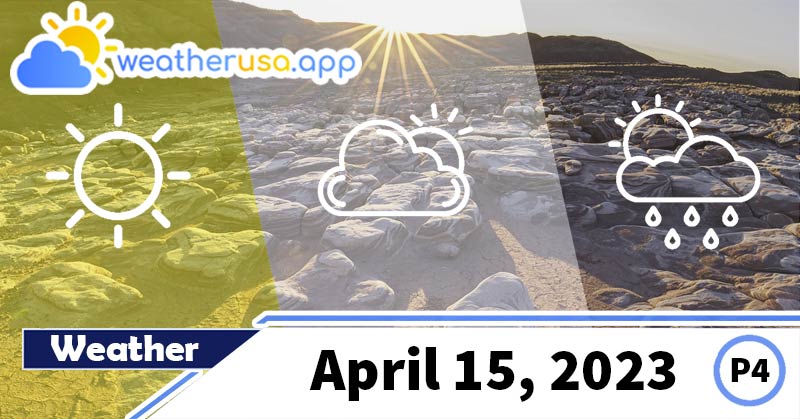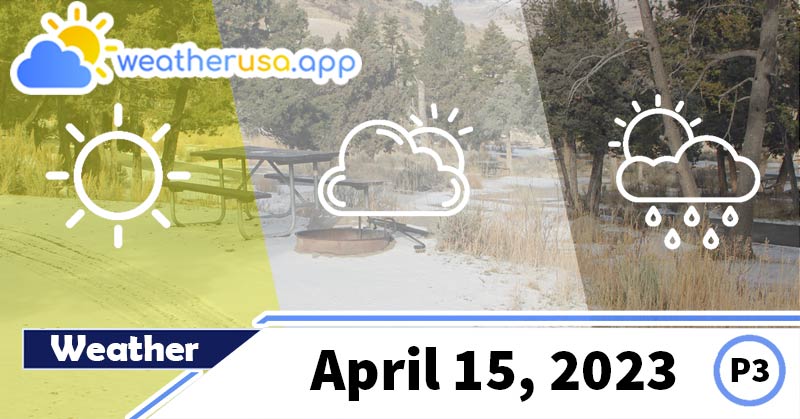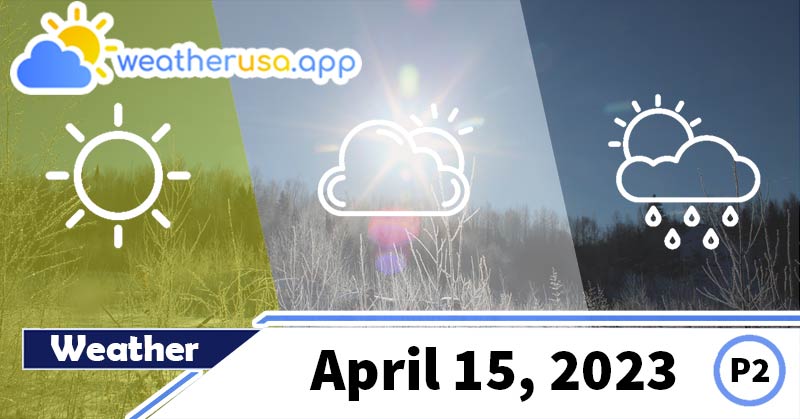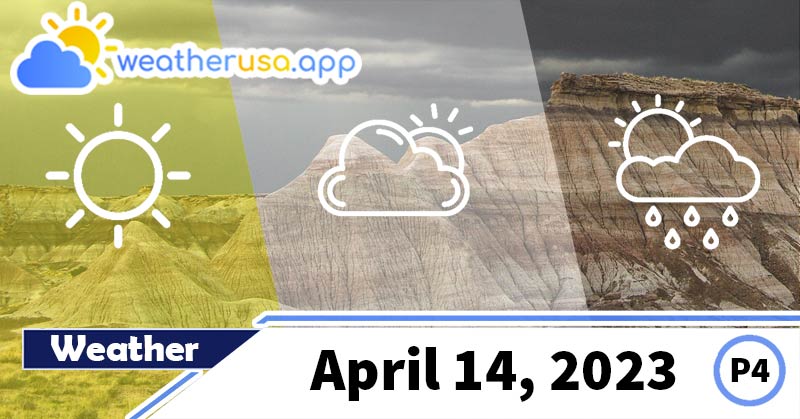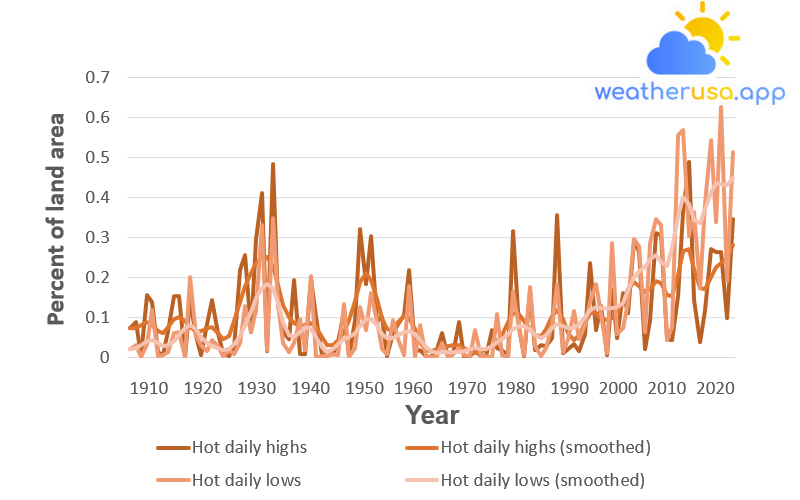
High and Low Temperatures
Climate Change Indicators: High and Low Temperatures
This indicator describes trends in unusually high and low temperatures in the United States.
Figure 1. Area of the Contiguous 48 States with Unusually Hot Summer Temperatures, 1910–2020

This chart shows the percentage of the land area of the contiguous 48 states with scorching daily high and low temperatures during June, July, and August. Thin lines represent individual years, while thick lines show the nine-year weighted average. Red lines represent daily highs, while orange lines represent daily lows. In this case, the term “unusual” is based on the long-term average conditions at each location.
| Year | Hot daily highs | Hot daily highs (smoothed) | Hot daily lows | Hot daily lows (smoothed) |
| 1910 | 0.074 | 0.071973 | 0.02 | 0.021004 |
| 1911 | 0.087 | 0.072895 | 0.031 | 0.023023 |
| 1912 | 0.004 | 0.080355 | 0 | 0.029832 |
| 1913 | 0.155 | 0.087617 | 0.033 | 0.039355 |
| 1914 | 0.139 | 0.08141 | 0.117 | 0.04232 |
| 1915 | 0.013 | 0.06507 | 0.004 | 0.035055 |
| 1916 | 0.005 | 0.060227 | 0.005 | 0.027449 |
| 1917 | 0.066 | 0.07627 | 0.013 | 0.029707 |
| 1918 | 0.153 | 0.095879 | 0.06 | 0.040785 |
| 1919 | 0.153 | 0.09991 | 0.063 | 0.056004 |
| 1920 | 0 | 0.089551 | 0.001 | 0.071945 |
| 1921 | 0.142 | 0.075813 | 0.202 | 0.079676 |
| 1922 | 0.052 | 0.065832 | 0.052 | 0.070625 |
| 1923 | 0.006 | 0.064969 | 0.031 | 0.051199 |
| 1924 | 0.084 | 0.072391 | 0.015 | 0.035711 |
| 1925 | 0.142 | 0.074578 | 0.044 | 0.02809 |
| 1926 | 0.06 | 0.061434 | 0.028 | 0.023027 |
| 1927 | 0.011 | 0.045438 | 0.002 | 0.018813 |
| 1928 | 0.004 | 0.051836 | 0.019 | 0.020203 |
| 1929 | 0.022 | 0.089527 | 0.009 | 0.032082 |
| 1930 | 0.219 | 0.139379 | 0.035 | 0.05391 |
| 1931 | 0.256 | 0.17943 | 0.129 | 0.081723 |
| 1932 | 0.062 | 0.209891 | 0.063 | 0.113754 |
| 1933 | 0.297 | 0.236883 | 0.119 | 0.147219 |
| 1934 | 0.411 | 0.253516 | 0.331 | 0.173672 |
| 1935 | 0.015 | 0.251668 | 0.017 | 0.184363 |
| 1936 | 0.484 | 0.22759 | 0.348 | 0.172543 |
| 1937 | 0.13 | 0.181828 | 0.133 | 0.135848 |
| 1938 | 0.063 | 0.131883 | 0.035 | 0.088617 |
| 1939 | 0.045 | 0.099523 | 0.014 | 0.056676 |
| 1940 | 0.193 | 0.084527 | 0.036 | 0.051488 |
| 1941 | 0.007 | 0.078223 | 0.096 | 0.06334 |
| 1942 | 0.009 | 0.081078 | 0.017 | 0.074965 |
| 1943 | 0.197 | 0.085699 | 0.204 | 0.071707 |
| 1944 | 0.101 | 0.074926 | 0.001 | 0.050797 |
| 1945 | 0.005 | 0.049363 | 0.002 | 0.025895 |
| 1946 | 0.007 | 0.029781 | 0.002 | 0.013879 |
| 1947 | 0.008 | 0.029586 | 0.007 | 0.019348 |
| 1948 | 0.038 | 0.043105 | 0.006 | 0.033758 |
| 1949 | 0.116 | 0.062316 | 0.133 | 0.045199 |
| 1950 | 0.001 | 0.092578 | 0 | 0.051402 |
| 1951 | 0.093 | 0.139941 | 0.023 | 0.061105 |
| 1952 | 0.322 | 0.188902 | 0.125 | 0.078547 |
| 1953 | 0.184 | 0.210813 | 0.067 | 0.094418 |
| 1954 | 0.303 | 0.192543 | 0.161 | 0.095555 |
| 1955 | 0.091 | 0.146445 | 0.09 | 0.079457 |
| 1956 | 0.101 | 0.098113 | 0.02 | 0.058621 |
| 1957 | 0.004 | 0.069664 | 0.008 | 0.047734 |
| 1958 | 0.06 | 0.068867 | 0.092 | 0.048785 |
| 1959 | 0.083 | 0.087121 | 0.046 | 0.055543 |
| 1960 | 0.105 | 0.103855 | 0.006 | 0.063352 |
| 1961 | 0.218 | 0.098922 | 0.177 | 0.06657 |
| 1962 | 0.015 | 0.070555 | 0 | 0.059121 |
| 1963 | 0.018 | 0.037387 | 0.081 | 0.042543 |
| 1964 | 0.004 | 0.017957 | 0.002 | 0.025242 |
| 1965 | 0 | 0.015137 | 0 | 0.014508 |
| 1966 | 0.02 | 0.020281 | 0.003 | 0.011598 |
| 1967 | 0.06 | 0.024746 | 0.035 | 0.012328 |
| 1968 | 0 | 0.027074 | 0 | 0.012648 |
| 1969 | 0.009 | 0.029383 | 0.009 | 0.012355 |
| 1970 | 0.089 | 0.029313 | 0.023 | 0.013051 |
| 1971 | 0.001 | 0.023438 | 0.005 | 0.015957 |
| 1972 | 0.003 | 0.015102 | 0.004 | 0.020207 |
| 1973 | 0.016 | 0.010828 | 0.069 | 0.02193 |
| 1974 | 0.002 | 0.013422 | 0 | 0.020125 |
| 1975 | 0.002 | 0.020824 | 0.004 | 0.020863 |
| 1976 | 0.068 | 0.028168 | 0.001 | 0.027918 |
| 1977 | 0.023 | 0.036043 | 0.107 | 0.036727 |
| 1978 | 0.019 | 0.055023 | 0.005 | 0.045422 |
| 1979 | 0.002 | 0.087156 | 0 | 0.058016 |
| 1980 | 0.316 | 0.111227 | 0.165 | 0.07168 |
| 1981 | 0.073 | 0.108824 | 0.075 | 0.078598 |
| 1982 | 0.002 | 0.089664 | 0.006 | 0.077785 |
| 1983 | 0.162 | 0.070848 | 0.176 | 0.070215 |
| 1984 | 0.018 | 0.056469 | 0.027 | 0.05634 |
| 1985 | 0.03 | 0.052422 | 0.004 | 0.046863 |
| 1986 | 0.027 | 0.070629 | 0.024 | 0.054813 |
| 1987 | 0.047 | 0.103102 | 0.083 | 0.073586 |
| 1988 | 0.356 | 0.11741 | 0.184 | 0.083223 |
| 1989 | 0.011 | 0.095988 | 0.014 | 0.078426 |
| 1990 | 0.021 | 0.060441 | 0.046 | 0.07193 |
| 1991 | 0.034 | 0.043559 | 0.116 | 0.073336 |
| 1992 | 0.015 | 0.056473 | 0.046 | 0.08309 |
| 1993 | 0.057 | 0.086336 | 0.081 | 0.099977 |
| 1994 | 0.236 | 0.109371 | 0.138 | 0.117453 |
| 1995 | 0.068 | 0.110887 | 0.183 | 0.124637 |
| 1996 | 0.127 | 0.099098 | 0.107 | 0.122629 |
| 1997 | 0.005 | 0.09216 | 0.01 | 0.122398 |
| 1998 | 0.17 | 0.097316 | 0.286 | 0.124242 |
| 1999 | 0.049 | 0.112582 | 0.057 | 0.124594 |
| 2000 | 0.16 | 0.138121 | 0.073 | 0.13575 |
| 2001 | 0.11 | 0.169617 | 0.137 | 0.166992 |
| 2002 | 0.293 | 0.187715 | 0.296 | 0.200004 |
| 2003 | 0.263 | 0.178695 | 0.279 | 0.215723 |
| 2004 | 0.02 | 0.163238 | 0.063 | 0.226195 |
| 2005 | 0.093 | 0.17134 | 0.286 | 0.245926 |
| 2006 | 0.311 | 0.190953 | 0.347 | 0.255652 |
| 2007 | 0.307 | 0.184551 | 0.33 | 0.237824 |
| 2008 | 0.045 | 0.155887 | 0.043 | 0.227566 |
| 2009 | 0.043 | 0.154387 | 0.076 | 0.273133 |
| 2010 | 0.153 | 0.204734 | 0.557 | 0.354852 |
| 2011 | 0.364 | 0.264707 | 0.568 | 0.401328 |
| 2012 | 0.489 | 0.272102 | 0.304 | 0.38357 |
| 2013 | 0.144 | 0.222043 | 0.364 | 0.344211 |
| 2014 | 0.039 | 0.172352 | 0.173 | 0.336945 |
| 2015 | 0.118 | 0.170012 | 0.386 | 0.371012 |
| 2016 | 0.271 | 0.201555 | 0.543 | 0.414891 |
| 2017 | 0.264 | 0.226715 | 0.338 | 0.436367 |
| 2018 | 0.263 | 0.234953 | 0.627 | 0.433582 |
| 2019 | 0.099 | 0.248465 | 0.191 | 0.431555 |
| 2020 | 0.347 | 0.280672 | 0.514 | 0.450316 |
Figure 1. Area of the Contiguous 48 States with Unusually Hot Summer Temperatures, 1910-2020
Data source: NOAA, 2021
Web update: April 2021
Units: Percent of land area
Figure 2. Area of the Contiguous 48 States with Unusually Cold Winter Temperatures, 1911–2020
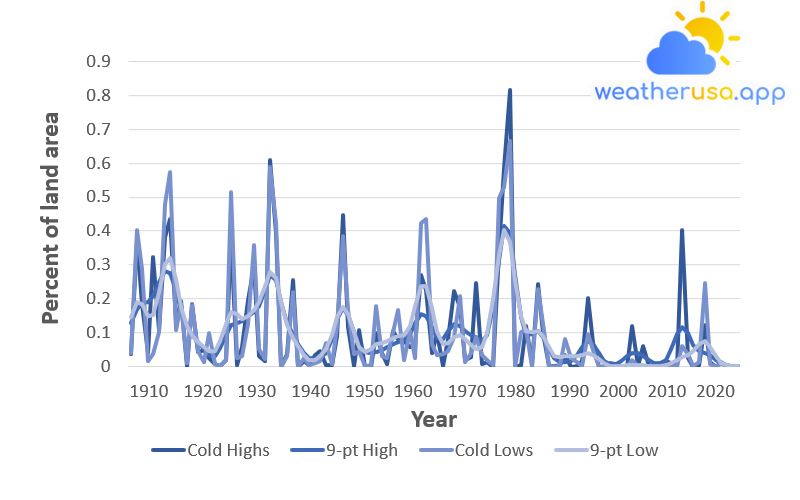
This chart shows the percentage of the land area of the contiguous 48 states with freezing daily high and low temperatures during December, January, and February.
Thin lines represent individual years, while thick lines show the nine-year weighted average. Blue lines represent daily highs, while purple lines represent daily lows. In this case, the term “unusual” is based on the long-term average conditions at each location.
| Year | Cold Highs | 9-pt High | Cold Lows | 9-pt Low |
| 1911 | 0.035 | 0.126672 | 0.04 | 0.145301 |
| 1912 | 0.374 | 0.169902 | 0.402 | 0.190211 |
| 1913 | 0.184 | 0.185695 | 0.286 | 0.184309 |
| 1914 | 0.038 | 0.18891 | 0.015 | 0.148504 |
| 1915 | 0.323 | 0.208172 | 0.037 | 0.150484 |
| 1916 | 0.108 | 0.247656 | 0.102 | 0.219836 |
| 1917 | 0.383 | 0.280922 | 0.479 | 0.302086 |
| 1918 | 0.434 | 0.27516 | 0.575 | 0.318707 |
| 1919 | 0.131 | 0.225828 | 0.106 | 0.257629 |
| 1920 | 0.194 | 0.163551 | 0.184 | 0.175063 |
| 1921 | 0.002 | 0.118738 | 0.01 | 0.119426 |
| 1922 | 0.183 | 0.093094 | 0.18 | 0.091336 |
| 1923 | 0.043 | 0.072402 | 0.044 | 0.072672 |
| 1924 | 0.049 | 0.05034 | 0.014 | 0.056512 |
| 1925 | 0.026 | 0.032305 | 0.098 | 0.044688 |
| 1926 | 0.008 | 0.029699 | 0.007 | 0.045633 |
| 1927 | 0.002 | 0.052902 | 0.002 | 0.074652 |
| 1928 | 0.019 | 0.093586 | 0.019 | 0.126039 |
| 1929 | 0.38 | 0.122879 | 0.514 | 0.159504 |
| 1930 | 0.004 | 0.129309 | 0.024 | 0.153152 |
| 1931 | 0.056 | 0.134301 | 0.031 | 0.139086 |
| 1932 | 0.195 | 0.148723 | 0.126 | 0.147207 |
| 1933 | 0.295 | 0.160012 | 0.359 | 0.165746 |
| 1934 | 0.031 | 0.178164 | 0.052 | 0.190156 |
| 1935 | 0.015 | 0.22559 | 0.022 | 0.23616 |
| 1936 | 0.608 | 0.27102 | 0.59 | 0.277863 |
| 1937 | 0.393 | 0.256207 | 0.423 | 0.260285 |
| 1938 | 0 | 0.188992 | 0 | 0.18857 |
| 1939 | 0.037 | 0.128203 | 0.03 | 0.121723 |
| 1940 | 0.254 | 0.09407 | 0.219 | 0.084949 |
| 1941 | 0 | 0.065992 | 0 | 0.059266 |
| 1942 | 0.015 | 0.038836 | 0.026 | 0.03466 |
| 1943 | 0.003 | 0.024688 | 0.003 | 0.019914 |
| 1944 | 0.034 | 0.023375 | 0.011 | 0.019281 |
| 1945 | 0.045 | 0.026516 | 0.017 | 0.029172 |
| 1946 | 0.004 | 0.040141 | 0.069 | 0.05102 |
| 1947 | 0.005 | 0.080367 | 0.006 | 0.092496 |
| 1948 | 0.09 | 0.138492 | 0.119 | 0.145758 |
| 1949 | 0.446 | 0.171566 | 0.386 | 0.175898 |
| 1950 | 0.117 | 0.151602 | 0.165 | 0.155871 |
| 1951 | 0.001 | 0.101492 | 0.036 | 0.102668 |
| 1952 | 0.108 | 0.060086 | 0.045 | 0.057066 |
| 1953 | 0 | 0.041238 | 0.001 | 0.042055 |
| 1954 | 0 | 0.038957 | 0.004 | 0.05143 |
| 1955 | 0.099 | 0.043531 | 0.177 | 0.064582 |
| 1956 | 0.04 | 0.048742 | 0.032 | 0.070137 |
| 1957 | 0.007 | 0.055641 | 0.026 | 0.074922 |
| 1958 | 0.104 | 0.06532 | 0.101 | 0.084164 |
| 1959 | 0.081 | 0.072949 | 0.167 | 0.089902 |
| 1960 | 0.074 | 0.07893 | 0.018 | 0.093539 |
| 1961 | 0.058 | 0.095363 | 0.103 | 0.11907 |
| 1962 | 0.066 | 0.127113 | 0.024 | 0.17909 |
| 1963 | 0.27 | 0.153867 | 0.424 | 0.237027 |
| 1964 | 0.226 | 0.149449 | 0.434 | 0.236797 |
| 1965 | 0.038 | 0.116379 | 0.066 | 0.17366 |
| 1966 | 0.097 | 0.08498 | 0.034 | 0.100953 |
| 1967 | 0.001 | 0.081414 | 0.036 | 0.065742 |
| 1968 | 0.081 | 0.103637 | 0.046 | 0.070082 |
| 1969 | 0.223 | 0.124039 | 0.086 | 0.087422 |
| 1970 | 0.175 | 0.120508 | 0.208 | 0.092121 |
| 1971 | 0.018 | 0.103211 | 0.014 | 0.079359 |
| 1972 | 0.027 | 0.09273 | 0.039 | 0.06241 |
| 1973 | 0.246 | 0.085773 | 0.086 | 0.051914 |
| 1974 | 0.007 | 0.075773 | 0.033 | 0.05584 |
| 1975 | 0.013 | 0.091891 | 0.02 | 0.09784 |
| 1976 | 0 | 0.175918 | 0.005 | 0.199332 |
| 1977 | 0.343 | 0.313629 | 0.496 | 0.329117 |
| 1978 | 0.585 | 0.414547 | 0.529 | 0.403469 |
| 1979 | 0.816 | 0.392965 | 0.665 | 0.366383 |
| 1980 | 0 | 0.268578 | 0 | 0.253539 |
| 1981 | 0.005 | 0.145371 | 0.1 | 0.150031 |
| 1982 | 0.119 | 0.093359 | 0.109 | 0.103453 |
| 1983 | 0.01 | 0.096633 | 0 | 0.101066 |
| 1984 | 0.244 | 0.103703 | 0.229 | 0.104914 |
| 1985 | 0.098 | 0.085695 | 0.124 | 0.088453 |
| 1986 | 0.001 | 0.051082 | 0.001 | 0.05591 |
| 1987 | 0.002 | 0.023641 | 0 | 0.031422 |
| 1988 | 0.004 | 0.013 | 0.004 | 0.026695 |
| 1989 | 0.033 | 0.012039 | 0.08 | 0.030668 |
| 1990 | 0 | 0.016492 | 0.026 | 0.030941 |
| 1991 | 0.002 | 0.032039 | 0.012 | 0.029953 |
| 1992 | 0.016 | 0.057594 | 0.001 | 0.034293 |
| 1993 | 0.202 | 0.074215 | 0.095 | 0.039164 |
| 1994 | 0.069 | 0.065203 | 0.048 | 0.034602 |
| 1995 | 0 | 0.038977 | 0 | 0.021188 |
| 1996 | 0 | 0.016766 | 0.001 | 0.008496 |
| 1997 | 0.01 | 0.007461 | 0 | 0.00216 |
| 1998 | 0.006 | 0.007852 | 0 | 0.000863 |
| 1999 | 0 | 0.015793 | 0 | 0.002039 |
| 2000 | 0 | 0.029176 | 0 | 0.004117 |
| 2001 | 0.12 | 0.039754 | 0.018 | 0.005391 |
| 2002 | 0.001 | 0.039656 | 0.001 | 0.004758 |
| 2003 | 0.059 | 0.03009 | 0.002 | 0.002969 |
| 2004 | 0.001 | 0.018262 | 0.001 | 0.001512 |
| 2005 | 0.003 | 0.010133 | 0 | 0.001012 |
| 2006 | 0 | 0.008891 | 0 | 0.001426 |
| 2007 | 0.017 | 0.019895 | 0.004 | 0.00348 |
| 2008 | 0.009 | 0.051105 | 0.001 | 0.009098 |
| 2009 | 0 | 0.094637 | 0.001 | 0.018215 |
| 2010 | 0.403 | 0.117566 | 0.06 | 0.026539 |
| 2011 | 0.024 | 0.099402 | 0.037 | 0.032973 |
| 2012 | 0 | 0.064129 | 0.002 | 0.045207 |
| 2013 | 0.004 | 0.044805 | 0.013 | 0.064535 |
| 2014 | 0.123 | 0.040332 | 0.246 | 0.073563 |
| 2015 | 0.014 | 0.032801 | 0.007 | 0.058449 |
| 2016 | 0 | 0.019734 | 0 | 0.031039 |
| 2017 | 0.014 | 0.009328 | 0.01 | 0.011238 |
| 2018 | 0 | 0.004199 | 0 | 0.003367 |
| 2019 | 0.001 | 0.001859 | 0 | 0.001121 |
| 2020 | 0 | 0.000656 | 0 | 0.000313 |
Figure 2. Area of the Contiguous 48 States with Unusually Cold Winter Temperatures, 1911-2020
Data source: NOAA, 2021
Web update: April 2021
Units: Percent of land area
Figure 3. Change in Unusually Hot Temperatures in the Contiguous 48 States, 1948–2020
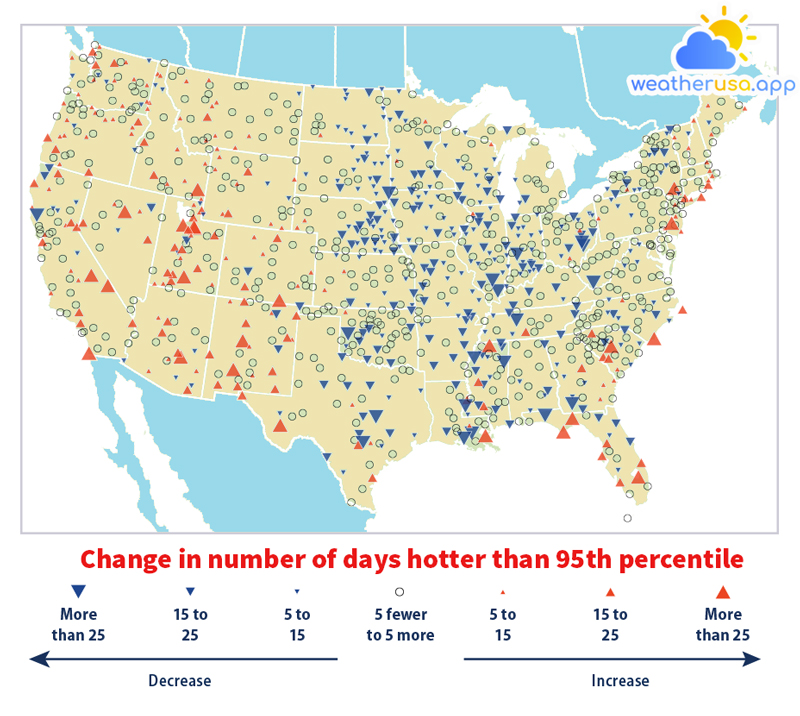
This map shows trends in unusually high temperatures at individual weather stations that have operated consistently since 1948. In this case, “unusually hot” refers to a daily maximum temperature more remarkable than the 95th percentile from 1948 to 2020.
Thus, the maximum temperature on a particular day at a specific station would be considered “unusually hot” if it falls within the warmest 5 percent of readings from 1948–2020. The map shows changes in the total number of days per year that were warmer than the 95th percentile.
The red upward-pointing symbols show where these scorching days are becoming more common. Blue downward-pointing symbols show where scorching days are becoming less common.
Figure 4. Change in Unusually Cold Temperatures in the Contiguous 48 States, 1948–2020
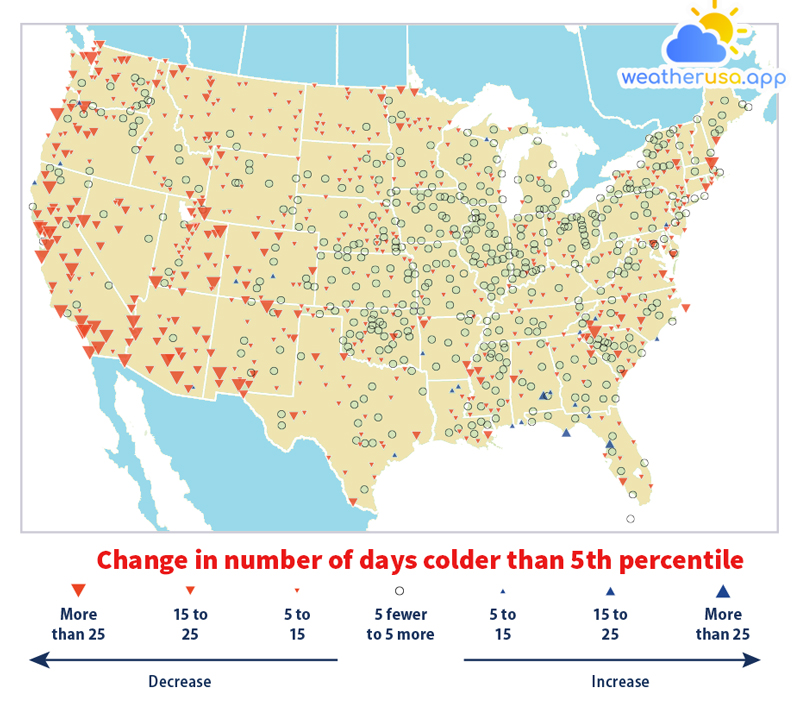
This map shows the trends of frigid temperatures at individual weather stations operating consistently since 1948. In this case, the term “unusually cold” refers to a daily minimum temperature below the 5th percentile for the period 1948–2020.
Thus, the minimum temperature on a particular day in a specific station would be considered “unusually cold” if it falls within the coldest 5 percent of readings from 1948 to 2020. The map shows changes in the total number of days per year harder than the 5th percentile.
Blue upward-pointing symbols show where these freezing days are more common. Red downward-pointing signs show where snowy days are becoming less common.
Figure 5. Record Daily High and Low Temperatures in the Contiguous 48 States, 1950–2009
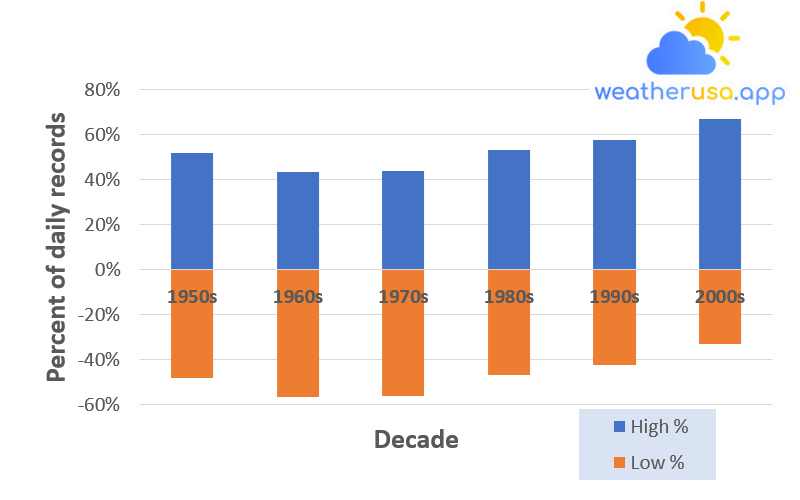
This figure shows the percentage of daily temperature records set at weather stations in the contiguous 48 states over a decade. Record highs are compared to record lows.
| Decade | High % | Low % |
| 1950s | 52.07% | -47.93% |
| 1960s | 43.55% | -56.45% |
| 1970s | 43.92% | -56.08% |
| 1980s | 53.17% | -46.83% |
| 1990s | 57.55% | -42.45% |
| 2000s | 67.16% | -32.84% |
Figure 5. Record Daily High and Low Temperatures in the Contiguous 48 States, 1950-2009
Data source: Meehl et al., 2009
Web update: April 2021
Units: Percent of daily records
Key Points
- Sweltering summer days (highs) have become more common across the country in the past few decades (see Figure 1). The incidence of muggy summer nights (lows) increased even faster. This trend suggests less “cooling” at night.
- The 20th century had many winters with widespread patterns of shallow temperatures, including a considerable increase in the late 1970s (see Figure 2). However, since the 1980s, freezing winter temperatures have become less common – especially very cold nights (lows).
- These two maps show where there have been changes in the number of days with unusually warm and cold days since 1948. Based on this way of looking at hot days, extraordinarily high temperatures increased in the western United States.
They decreased in a few areas along the Gulf and Atlantic coasts in much of the central part of the country (see Figure 3). The number of freezing days generally decreased across the country, especially in the western United States (see Figure 4). - If the climate were utterly stable, highs and lows would be expected to account for about 50 percent of recorded records. However, since the 1970s, record daily high temperatures have been more common in the United States than record lows (see Figure 5). The decade from 2000 to 2009 had twice as many record highs as record lows.
Background
- Unusually high or low temperatures can result in prolonged extreme weather events such as summer heat waves or winter cold spells. Heat waves can lead to illness and death, especially among older adults, the very young, and other vulnerable populations.
People can also die from exposure to extreme cold. Additionally, prolonged exposure to excessive heat and cold can damage crops and injure or kill livestock. Extreme heat can lead to power outages as heavy demands for air conditioning strain the power grid, while extremely cold weather increases the need for heating fuel. - Record daily temperatures, heat waves, and cold spells are a natural part of daily weather changes. But as the Earth’s climate warms overall, heat waves are expected to become more frequent and intense. Higher heat index values are expected to increase discomfort and exacerbate health problems.
On the contrary, the cold season is expected to decrease. In most places, scientists expect daily minimum temperatures — typically at night — to warm faster than daily maximum temperatures. This change will provide fewer opportunities to cool down and recover from the day’s heat.
About the Indicator
This indicator examines unusual temperature trends from several perspectives.
- The country has scorching summer and cold winter temperatures (Figures 1 and 2).
- Change in the number of days with unusually high and low temperatures at individual weather stations (Figures 3 and 4).
- Changes in record high and low temperatures (Figure 5).
- The data comes from thousands of weather stations across the United States. National patterns can be determined by dividing the country into a grid and examining the data for one station in each grid cell. This method ensures that the results are not biased towards areas with many stations close together.
- Figures 1 and 2 show trends in the percentage of the country’s area experiencing unusually high summer temperatures and shallow winter temperatures.
These charts are based on daily maximum temperatures that typically occur during the day and daily minimum temperatures that usually occur at night. At each station, the recorded highs and lows are compared to the complete set of historical records.
When averaged over a particular month or period of interest, the coldest 10 percent of years are considered “unusually cold” and the warmest 10 percent “unusually hot.” For example, if last year’s summer highs were the 10th most generous for a particular location with more than 100 years of data, this year’s summer highs would be considered unusually warm. - Figures 3 and 4 show how trends in unusually high and low daily temperatures vary by location throughout the year. These maps cover about 1,100 weather stations that have been in operation since 1948.
Figure 3 was created by summarizing all daily maximum temperatures from 1948 to 2020 and identifying the 95th percentile temperature at each station. Additionally, the total number of days with maximum temperatures more excellent than the 95th percentile was determined for each year.
The map shows how the number of sweltering days per year at individual stations has changed. Figure 4 is similar, except it looks at freezing days based on the 5th percentile of daily minimum temperatures. - Many people are familiar with record daily high and low temperatures that are often mentioned in weather reports. Figure 5 shows the trends in these records by comparing the number of record highs with the number of record lows for the decade. This data comes from a set of weather stations that have been collecting data consistently since 1950.
About the Data
Indicator Notes
Temperature data is less certain for the early 20th century because fewer stations were operating then. Additionally, measuring instruments and methods have changed over time, and some stations have moved. The data have been adjusted as much as possible to account for some of these effects and biases. Still, these uncertainties are insufficient to change the underlying trends shown in the figures.
Data Sources
The data for this indicator is based on measurements from weather stations managed by the National Oceanic and Atmospheric Administration. Figures 1 and 2 are from the US Index of Climate Extremes, which is based on a smaller group of long-term weather stations monitored by the National Center for Environmental Information and referred to as the US Historical Climatology Network.
Figures 3 and 4 use data from a more extensive set of stations monitored by the National Center for Environmental Information, known as the Global Historical Climatology Network. Figure 5 uses National Weather Service data processed by Meehl et al.
Weather 01852 - Lowell MA

50°
moderate rain
Feels like 47°05:33/19:49
52°F
/47°F
79%
1022 hPa
7 mi
8.05 mph
